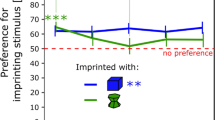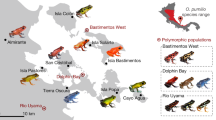Abstract
SEVERAL species of bird have been found to direct their first sexual responses towards objects already familiar to them. The preferences of the birds were at least partially affected by experience occurring before sexual behaviour had matured or was artificially induced1–4. Lorenz1 argued that this long-term effect of ‘imprinting’, as the learning process has been called, is one of the criteria which distinguishes it from ‘associative learning’. At the time this view seemed justifiable since it was generally supposed that associative learning involves the attachment of a specific response to a specific stimulus. However, more recently it has been shown that an animal can use familiar cues more readily than those of which it has had no previous experience, regardless of the response which must be given5,6. This suggests that the long-term effect of imprinting on sexual behaviour is only one aspect of a more general consequence of the learning process and should not be regarded as a special feature of imprinting. The experiment described here provided preliminary evidence that birds can more easily distinguish an imprinted stimulus than unfamiliar stimuli in a situation which does not involve filial or sexual responses. The experiment made use of the finding that isolated domestic chicks (Gallus domesticus) can learn the characteristics of the pens in which they are reared7.
This is a preview of subscription content, access via your institution
Access options
Subscribe to this journal
Receive 51 print issues and online access
$199.00 per year
only $3.90 per issue
Buy this article
- Purchase on Springer Link
- Instant access to full article PDF
Prices may be subject to local taxes which are calculated during checkout
Similar content being viewed by others
References
Lorenz, K., J. Ornithol., 83, 137, 289 (1935).
Guiton, P., Anim. Behav., 9, 167 (1961).
Bambridge, R., Science, 136, 259 (1962).
Schutz, F., Naturwiss., 50, 624 (1963).
Lawrence, D. H., J. Exp. Psychol., 39, 770 (1949).
Gibson, E. J., and Walk, R. D., J. Comp. Physiol. Psychol., 49, 239 (1956).
Bateson, P. P. G., J. Comp. Physiol. Psychol., 57, 100 (1964).
Bateson, P. P. G., J. Comp. Physiol. Psychol. (in the press).
Author information
Authors and Affiliations
Rights and permissions
About this article
Cite this article
BATESON, P. An Effect of Imprinting on the Perceptual Development of Domestic Chicks. Nature 202, 421–422 (1964). https://doi.org/10.1038/202421a0
Issue Date:
DOI: https://doi.org/10.1038/202421a0
This article is cited by
-
Imprinting-Type Memorization of Information in Adult BALB/c Mice
Neuroscience and Behavioral Physiology (2013)
-
Effects of previous exposure on olfactory discrimination in Acomys cahirinus
Nature (1974)
-
Retardation of Discrimination Learning in Monkeys and Chicks Previously Exposed to Both Stimuli
Nature (1972)
Comments
By submitting a comment you agree to abide by our Terms and Community Guidelines. If you find something abusive or that does not comply with our terms or guidelines please flag it as inappropriate.



